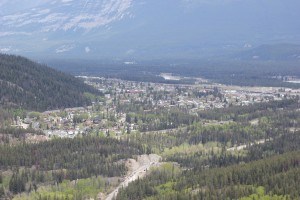
As the pressure increases on the municipality to find new ways to generate revenue, local businesses are making it clear they would prefer a new revenue sharing agreement with the province instead of more taxes.
For the past several years the municipality of Jasper has been working with the towns of Banff and Canmore to be recognized by the province as tourism-based communities.
The hope is that if the communities are given special status, the province will provide the municipalities with additional revenue tools to put more money back into their coffers.
“At the end of the day it’s 5,000 people being taxed to pay for upwards of 25,000 visitors per day using the town’s services and infrastructure,” said Mark Fercho, the town’s chief administrative officer.
He said the current situation is unsustainable in the long-term because local taxpayers pay for the services and the infrastructure required to support more than two million visitors annually.
“Alberta benefits as a province from all of the tourism revenue that comes to Jasper to the tune of $141,000 in taxes a day,” Fercho said, during the first of two public consultation sessions hosted by the Jasper Park Chamber of Commerce, March 1.
Under current legislation, the municipality’s only way to capture some of the tourism revenue generated by visitors is to charge different tax rates for commercial and residential users.
For example, the commercial property tax rate is currently set at 5.1 to 1, which means businesses pay five times more taxes than residential property owners, based on their property’s assessed value. Utility rates are also structured differently for commercial and residential users.
With businesses and residents shouldering the financial burden, the three communities collaborated on a study last year that looked at the challenges of servicing visitor volumes that far exceed resident population.
According to the report—prepared by Grant Thornton LLP—tourism-based communities make up less than one per cent of Alberta’s population, but play host to 13 per cent of the province’s visitors, attracting more than four million tourists annually.
Financially, visitor spending in Jasper alone results in an estimated $375 million in annual gross provincial income and supports nearly 5,000 full-time jobs in the province.
“It’s over a million dollars a day of economic activity,” said Fercho.
According to the report, tax revenues to all three levels of government are about $154.5 million annually or approximately $423,000 per day and growing.
Breaking that down, the federal government claims the largest piece of the pie, collecting about $97.1 million annually or about $266,000 in taxes per day, while the province rakes in about $51.3 million annually, more than $141,000 per day.
In comparison, the municipality collects about $4.3 million or about $12,000 per day.
The federal government’s share does not include gate fees collected by Parks Canada.
This is the second report the three municipalities have worked together on. In August 2015, the towns released a report highlighting the unique service demands tourism communities face.
That report recommended giving the municipalities a range of revenue tools to meet their needs, including a tourist consumption levy, a real estate transfer levy and provincial/municipal revenue sharing arrangement.
Fercho said it was too soon to speculate what revenue tool would be the best option, adding the first step is to be recognized as a tourism-based community.
Rusty Noble, the chamber’s president, agreed that something needs to be done, but said adding a consumption tax was not the solution.
“At the end of the day, we need to come to a solution that doesn’t burden either the personal taxpayer or the commercial taxpayer in one form or another.”
Coun. Rico Damota acknowledged the business community’s concerns that the municipality, if given additional revenue tools by the province, could implement a consumption tax.
“I know there is a fear of a consumption tax or whatever it may be, but we’re not going to advance anywhere unless we test the waters,” said Rico, reiterating the first step is to be recognized as a tourism-based community.
Bernhard Schneider, general manager for Mountain Park Lodges, said he was also opposed to a consumption tax.
“In our mind we already pay a consumption tax,” Schneider said, pointing to the mill rate split and utility rates for water and sewage.
“We’re already paying based on usage for certain things because it goes up and down depending on business levels, so to add a tax on top of that, we’re not happy.”
While a lot of discussion was focused on the province, Fercho said another possible solution could also include renegotiating the municipality’s land rent agreement with Parks Canada.
“I’m only aware of two communities in Canada that pay land rent, Jasper and Banff.”
According to Fercho, Banff’s land rent is capped at $550,000 per year, while Jasper’s land rent is indexed to the consumer price index, continually increasing year after year.
According to this year’s budget, Jasper will pay Parks Canada eight per cent or approximately $623,000 in municipal taxes for land rent and planning.
Paul Clarke
[email protected]
